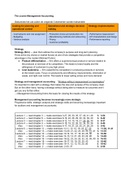Samenvatting
Samenvatting Management Accounting EUR bedrijfskunde jaar 2
- Instelling
- Erasmus Universiteit Rotterdam (EUR)
Uitgebreide collegesamenvatting van het vak Management Accounting aan de Erasmus Universiteit jaar 2 studie Bedrijfskunde. Grotendeels in het Engels.
[Meer zien]




